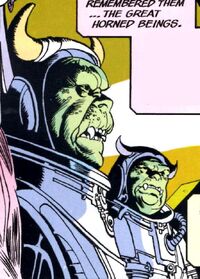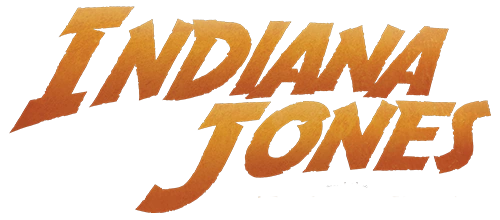- Williams: "What are they? Spacemen?"
- Oxley: "Interdimensional beings in point of fact."
- ―Mutt Williams and Harold Oxley[src]
Interdimensional beings influenced the beginnings of various human civilizations. They were humanoids but stood at an average height of nine feet, and their heads were elongated. Instead of bone, their skeletons were made of a crystalline property which held magnetic qualities.
History[]
- "Collectors. They were archaeologists."
- ―Indiana Jones[src]
According to Harold Oxley, they were not from space, but from the "space between spaces", and they traveled with flying saucers. Thirteen beings arrived on Earth about 7,000 years before the mid-20th century. According to the murals found in the entrance of Akator, they taught the Ugha agriculture, irrigation and technology. The Ugha worshiped them as gods and carved out the vast Nazca Lines in the deserts of Nazca, Peru as a tribute. Indiana Jones noticed that the Ugha had the custom to wrap their children's heads to cause an elongated shape, in order to "honor the gods". Jones also discovered that the beings' other major activity was, much like human archaeologists, the collecting of artifacts from many ancient cultures all over the world.[1]

Wall painting of a ring of thirteen interdimensional beings
Those thirteen beings were situated in the Temple of Akator, perhaps as a kind of ruling council. According to Irina Spalko, they thought and acted as a hive mind and a single being. For some reason they were left there as crystal skeletons. Centuries later, Francisco de Orellana found the temple during his search for the legendary town of El Dorado. Among other treasures, he took the crystal skull of one such skeleton. During his trip back, the mental power of the skull forced him to return it to Akator, but he was killed before he could do so and buried together with the skull. The legend about the robbery spread and said that he who would return the skull would receive great power.[1]
More beings visited Earth to search for the missing thirteen. Two of their vehicles crashed in what became USSR territory, including an event in Siberia in 1908 near the Tunguska River. A third crashed in Roswell in 1947. Jones was part of the team ordered to examine the remains of a "mutilated" body from the site in absolute secrecy. The body was kept in Hangar 51 in Nevada until it was stolen by Irina Spalko's team ten years later.[2]

The crystal skeletons at Akator.
When Jones had recovered the missing skull and reached the Temple of Akator with his companions, followed by Spalko and her soldiers, they found the thirteen crystal skeletons, one of them headless. Spalko joined the skull to the skeleton, which, through Oxley, started to speak in the Mayan language, saying it would give them a great gift. Spalko demanded to know everything, and the thirteen started firing knowledge out of their skulls into her eyes. The Temple started to collapse, opening a portal to another dimension. Indy's band managed to escape from the temple.[1]
Meanwhile, the thirteen skeletons joined together to form a single being right before Spalko. The knowledge from the beings began to overwhelm her. She begged it to stop but the beings continued the transfer. Spalko's eyes ignited and her body disintegrated. Her remains were sucked into the portal and the other Soviets in the room were pulled in as well by their weapons and ammo belts.[1]
Jones, Marion Ravenwood, Mutt Williams and Oxley found their way out above the valley of Akator, and observed the temple's collapse, revealing a huge flying saucer which vanished soon after. Indy asked Oxley if the ship went into space. "Not into space," he replied, "but into the space between spaces".[1]
Behind the scenes[]
The interdimensional beings first appeared in Indiana Jones and the Kingdom of the Crystal Skull, an invention for the film.[1] The concept of including aliens as the MacGuffin in the fourth Indiana Jones film came about in part due to the 1950s setting, a time in which B-movies featuring aliens were prevalent. However, director Steven Spielberg intially pushed against the concept as he had already done "alien films" by the time the fourth film started development such as 1977's Close Encounters of the Third Kind and 1982's E.T. the Extra-Terrestrial[3] and he was reluctant for the Indiana Jones series to mix genres. Following the successful release of Roland Emmerich's 1996 film Independence Day, George Lucas revised the concept, moving away from flying saucers, which were a large element of Independence Day and reframing the aliens as interdimensional travelers.[4]

The horned beings of Atlantis.
Likely a coincidence due to Hal Barwood asserting that George Lucas had little involvement with most LucasArts projects,[5] the depiction of the horned beings of Indiana Jones and the Fate of Atlantis,[6] particularly in Dark Horse Comics' comic book adaptation,[7] is similar in premise to that of the later interdimensional beings from Kingdom of the Crystal Skull. Much like their interdimensional counterparts,[1] the horned entities played a role in the development of an ancient culture that led to them raising a city in their honor and once they achieve what they came to do, they depart Earth in their ships without leaving a trace.[7]
Appearances[]
- Indiana Jones and the Kingdom of the Crystal Skull
- Indiana Jones and the Kingdom of the Crystal Skull novel
- Indiana Jones and the Kingdom of the Crystal Skull 2
- Indiana Jones: Traps and Snares
- LEGO Indiana Jones 2: The Adventure Continues (Non-canonical appearance)
Sources[]
Notes and references[]
- ↑ 1.0 1.1 1.2 1.3 1.4 1.5 1.6 1.7 1.8 1.9 Indiana Jones and the Kingdom of the Crystal Skull
- ↑ Indiana Jones and the Kingdom of the Crystal Skull novel
- ↑ Production Diary: Making of "The Kingdom of the Crystal Skull"
- ↑ The Complete Making of Indiana Jones
- ↑ Interview to Hal Barwood at El Recoveco del Geek (Spanish site)
- ↑ Indiana Jones and the Fate of Atlantis
- ↑ 7.0 7.1 Indiana Jones and the Fate of Atlantis comic
